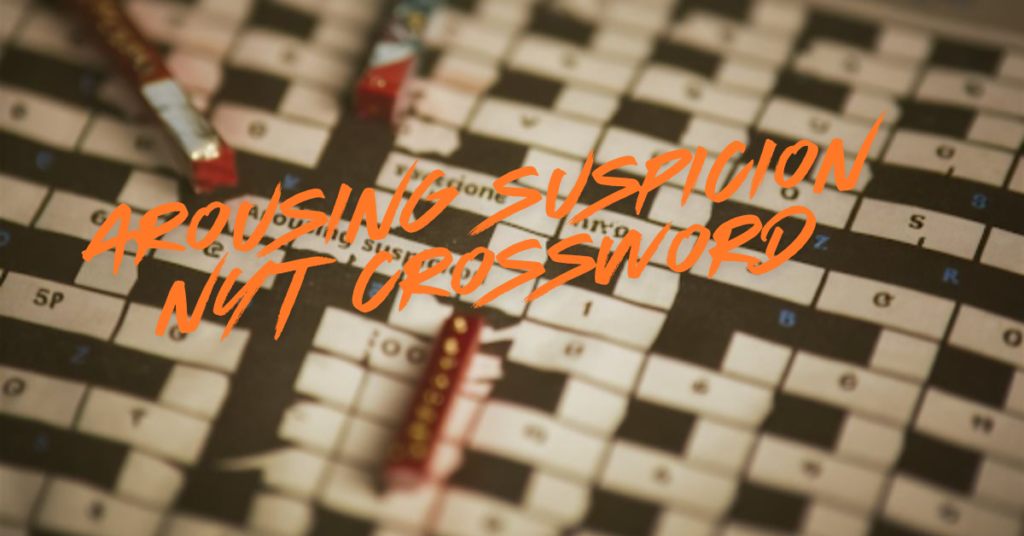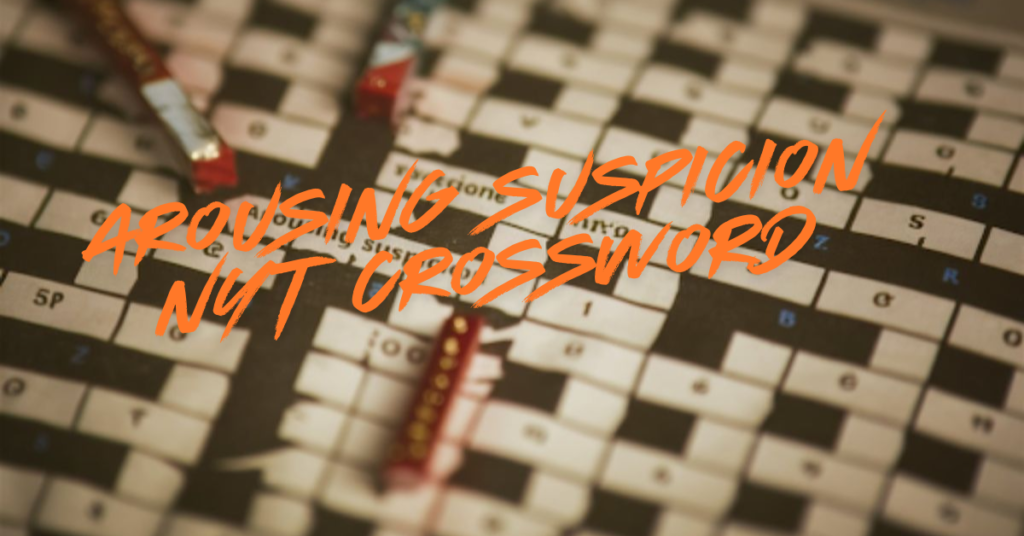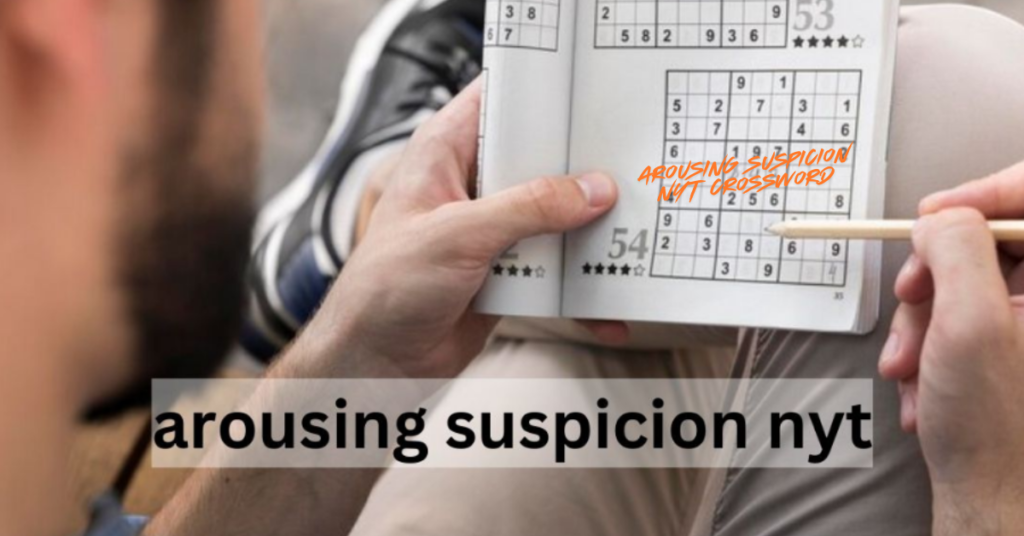The New York Times (NYT) Crossword is more than just a puzzle—it’s an intellectual challenge that has captivated solvers for decades. With its clever wordplay and engaging clues, the crossword tests your vocabulary, logic, and ability to think outside the box. One clue that regularly makes an appearance in various formats is “Arousing Suspicion.” If you’ve ever come across this clue, you know it can vary in complexity, but there are specific strategies and tips you can use to solve it with ease. This comprehensive guide will explore the meaning behind the clue, its variations, and how to approach solving it, helping you become a more proficient crossword solver.
What Does “Arousing Suspicion” Mean in the NYT Crossword?
To tackle the clue “Arousing Suspicion,” it’s crucial to understand the meaning behind the words. In the context of the NYT Crossword, this phrase typically refers to situations or behaviors that create doubt, distrust, or concern. Something that “arouses suspicion” often seems unusual, untrustworthy, or problematic. Think of words or actions that might suggest something isn’t quite right, such as:
- A suspicious action
- A person behaving in an odd or untrustworthy manner
- A situation that causes doubt or skepticism
In the crossword world, these clues are often worded in a way that challenges solvers to think beyond the literal definition. The word “arousing” suggests that something is causing or stirring up suspicion, while “suspicion” refers to doubt or mistrust. Therefore, solving this clue often involves identifying a word that encapsulates these feelings of doubt or suspicion in a concise form.
Common Variations of the Clue “Arousing Suspicion” in the NYT Crossword

The clue “Arousing Suspicion” can appear in different formats depending on the puzzle’s difficulty level. Here are some common variations you might encounter:
Arousing Suspicion NYT Mini Crossword
The NYT Mini Crossword is a condensed version of the full puzzle, designed to be quicker and simpler. While the clues are generally easier, you’ll still encounter the “arousing suspicion” clue. Here, the clue is typically shorter and might focus on more immediate, simple answers like “shady” or “fishy.” You’ll often find that these short clues come with less complex wordplay, but they still require you to think outside the box.
Arousing Suspicion NYT Crossword Clue with 5 Letters
Sometimes, the crossword will specify that the answer to the “arousing suspicion” clue must be five letters long. This requires a different approach because you need to narrow down possible answers that fit within the constraints of the puzzle. Words like “dodgy,” “shady,” and “fishy” are all common answers in this scenario. These words capture the essence of suspicion—something that doesn’t quite sit right but may not be immediately obvious.
Arousing Suspicion NYT Crossword Clue with More Than One Word
In some puzzles, the answer to this clue may be more than just a single word. You may come across answers like “sparking doubt” or “raising questions.” These two-word solutions still fit the broader meaning of the clue, but solving them can require a bit more patience and insight into how multi-word answers fit into the puzzle grid.
Why is “Arousing Suspicion” Such a Challenging Clue in the NYT Crossword?
The phrase “arousing suspicion” is inherently abstract, and it often requires solvers to think figuratively rather than literally. This can make it a tough clue for beginners, as it relies on understanding both synonyms and idiomatic expressions. Additionally, crossword puzzles often employ tricky wordplay, including:
- Synonyms and Near-Synonyms
In the case of “arousing suspicion,” the solver needs to come up with words that convey doubt, mistrust, or concern. Common answers like “shady,” “suspect,” and “fishy” are all synonyms of suspicion, but they come with different nuances and tones. Knowing when to use one word over another depends on the surrounding clues in the puzzle. - Wordplay and Double Meanings
Crosswords are known for their use of puns and double meanings. A clue like “arousing suspicion” might refer to something that is literally suspicious, like a shady character or an unusual action, but it could also refer to something more abstract. For example, a situation in which someone behaves oddly could be described as “raising questions,” a more figurative interpretation of suspicion. - Multiple Answer Formats
Depending on the puzzle, the answer to the “arousing suspicion” clue could vary in length or structure. This flexibility can make the clue more challenging, as solvers need to consider the length of the answer and the intersection with other clues.
How to Solve the “Arousing Suspicion” NYT Crossword Clue

Now that we understand the meaning behind the clue “arousing suspicion” and why it can be tricky, let’s explore how to approach solving it. Here are some tips and strategies to help you tackle this clue in both the mini and full NYT crossword puzzles:
1. Consider Synonyms for “Suspicion”
The first step in solving this clue is to think about synonyms for the word “suspicion.” Here are some common ones to keep in mind:
- Shady – Often used to describe something or someone that seems untrustworthy or suspicious.
- Fishy – Refers to something that seems strange or questionable.
- Dodgy – A British term meaning something that is suspicious or unreliable.
- Suspect – A person who is believed to be involved in something questionable or criminal.
- Dubious – Describes something that is doubtful or uncertain.
2. Look for Surrounding Clues
Crossword clues often make more sense when you consider the surrounding answers. If the clue “arousing suspicion” crosses with another word, it may help you narrow down possible answers. For example, if you know that a neighboring clue has the answer “spy,” you might deduce that “shady” is a likely answer for “arousing suspicion.”
3. Think About Idiomatic Phrases
Sometimes, the answer to a crossword clue isn’t a direct synonym of the words in the clue, but rather an idiomatic expression that fits the overall meaning. Phrases like “raises eyebrows” or “raises doubts” could be answers, particularly if the clue is in the longer format.
4. Use Crossword-Specific Tools
There are many online tools that can help you when you’re stuck on a crossword clue. Crossword solver websites allow you to input known letters and word length to generate possible solutions. For instance, if you’re working on a clue like “arousing suspicion” with a known length of five letters, these tools can quickly suggest words that fit, such as “shady” or “suspect.”
Common Answers for “Arousing Suspicion” in NYT Crosswords

While the answers to “arousing suspicion” can vary, some common ones appear regularly. These include:
- Shady
One of the most frequently used answers for “arousing suspicion,” as it conveys the idea of something that seems untrustworthy or dubious. - Fishy
A classic crossword answer that refers to something that doesn’t feel quite right or raises doubts. - Suspect
While not always the most common answer, “suspect” can appear, particularly in puzzles that deal with crime or mystery themes. - Dodgy
A common synonym for “suspicious,” particularly in British English, and often appears in crosswords that aim to include international slang. - Dubious
An answer that suggests doubt or hesitation, making it a suitable response to this clue.
Tips for Becoming a Better NYT Crossword Solver

Crossword solving is a skill that improves with practice. Here are some tips to help you sharpen your skills and improve your success rate with challenging clues like “arousing suspicion”:
1. Solve Crosswords Regularly
The best way to get better at crosswords is to practice regularly. Make it a habit to solve the NYT Crossword daily, whether it’s the mini or the full-size version. Over time, you’ll become familiar with common phrases, word patterns, and types of clues.
2. Expand Your Vocabulary
The more words you know, the easier it will be to solve crossword clues. Reading books, articles, and other crossword puzzles can expose you to new words and phrases, expanding your vocabulary and improving your solving skills.
3. Don’t Be Afraid to Skip Around
If you’re stuck on one clue, don’t be afraid to move on to another. Sometimes solving adjacent clues will provide letters that can help you with the more difficult ones. This strategy can be particularly useful for challenging clues like “arousing suspicion.”
4. Use the Internet Sparingly
While it’s helpful to use online resources, try to solve as much as possible on your own first. Using an online crossword solver or a dictionary can help when you’re truly stuck, but it’s important to practice your problem-solving skills without relying on external help too often.
Conclusion
The “Arousing Suspicion” NYT Crossword clue is a perfect example of how crossword puzzles test not only your vocabulary but also your ability to think creatively and infer meaning. Whether you’re dealing with the Mini or full-size crossword, this clue often involves interpreting figurative language, understanding synonyms, and recognizing wordplay.
By practicing regularly, expanding your vocabulary, and using strategies like considering surrounding clues, you’ll find yourself solving more efficiently and with confidence. While it can be challenging at first, with experience, you’ll begin to recognize common patterns and answers, making even tricky clues like “arousing suspicion” easier to solve. So, keep solving and honing your crossword skills—you’ll soon be a crossword pro, able to crack even the most perplexing clues with ease!
Frequently Asked Questions (FAQ)
1. What does “Arousing Suspicion” mean in the NYT Crossword?
The phrase “Arousing Suspicion” refers to actions, behaviors, or situations that cause doubt or mistrust. In the context of crossword puzzles, it typically points to words that convey doubt, unease, or untrustworthiness, such as “shady,” “fishy,” or “dodgy.”
2. What are common answers for “Arousing Suspicion” in the NYT Crossword?
Some common answers for this clue include “shady,” “suspect,” “fishy,” “dodgy,” and “dubious.” The exact answer depends on the number of letters required and the context of the puzzle.
3. How do I solve the “Arousing Suspicion” clue in the NYT Crossword?
To solve this clue, think of synonyms for suspicion like “shady” or “fishy.” Pay attention to the number of letters and the surrounding clues, which can help you narrow down possible answers. Additionally, practicing regularly and using crossword-solving tools can improve your solving skills.
4. Is “Arousing Suspicion” a common clue in the NYT Crossword?
Yes, “Arousing Suspicion” appears regularly in the NYT Crossword, especially in puzzles with themes related to mystery, crime, or psychological elements. It is also a common clue in the NYT Mini Crossword, though it might be simplified in that version.
5. Can I use online tools to help solve the “Arousing Suspicion” clue?
While it’s best to solve the crossword independently to develop your skills, you can use online crossword solvers if you get stuck. These tools can provide suggestions based on the letters you already have, helping you find the correct answer more quickly. However, relying too much on these tools can limit your learning and problem-solving growth.
Looking for insights on the Beam of Sunshine NYT Crossword? Check out our detailed guide here!



